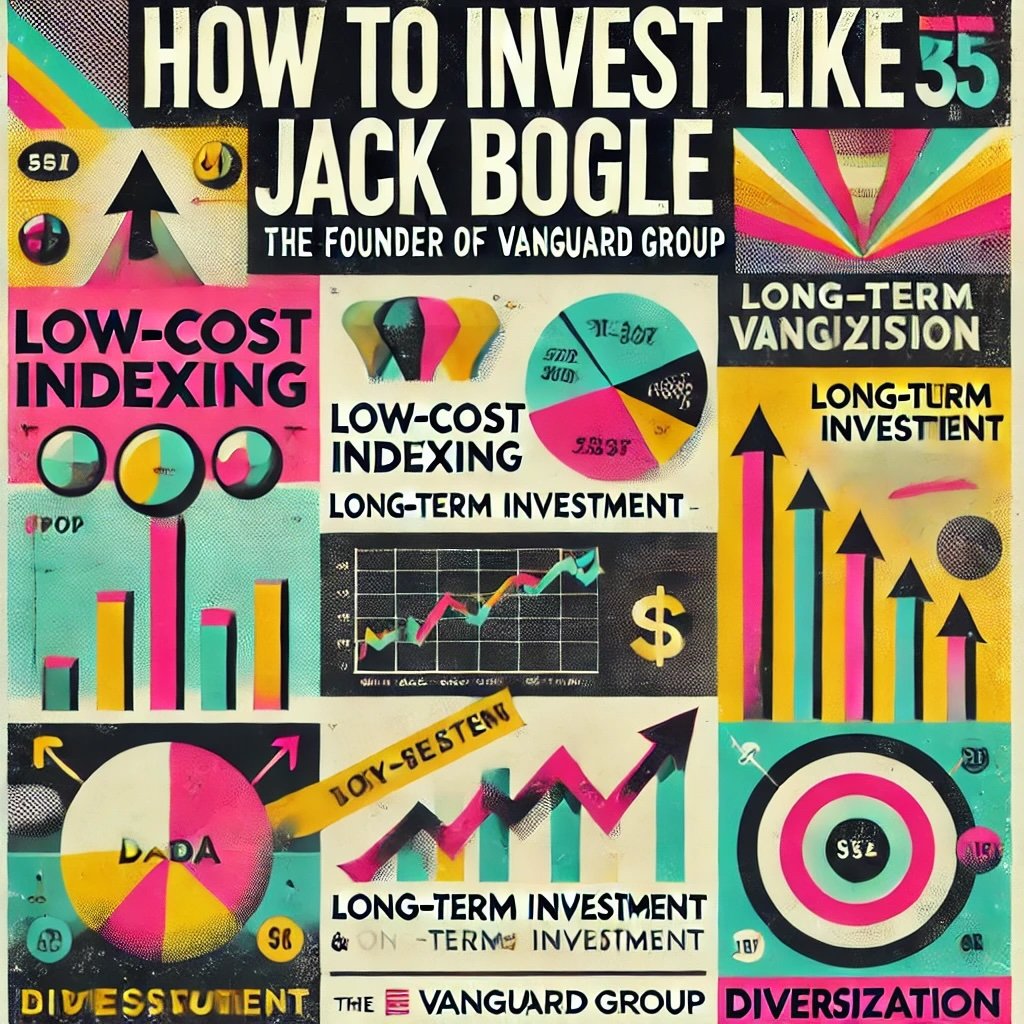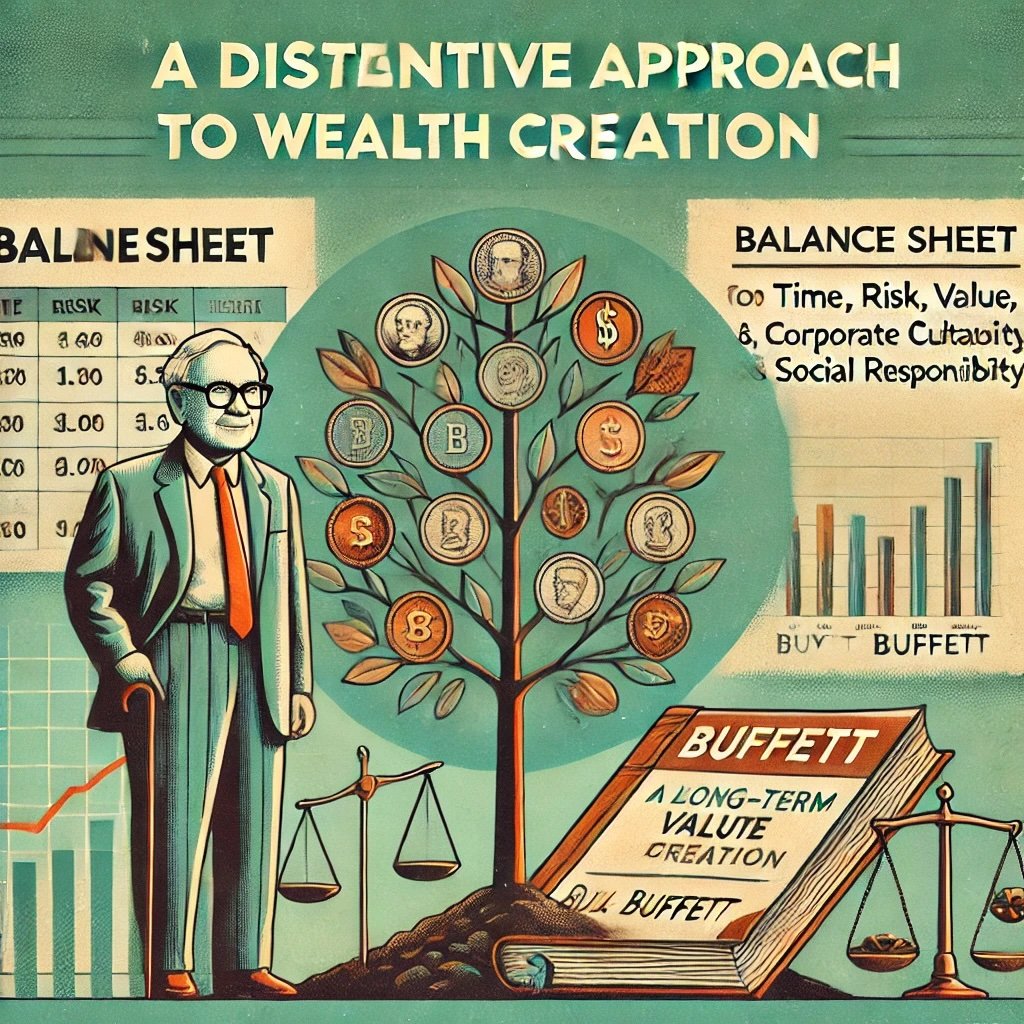Investing like a seasoned trader isn’t just about understanding the markets—it’s about mastering strategies, disciplined risk management, and leveraging deep market insights. David Druz, a renowned trend-following trader and market wizard, exemplifies these qualities through his innovative approaches and steadfast principles. In this comprehensive guide, we’ll explore David Druz’s trading strategies, delve into his trend-following philosophy, and uncover the principles that have made him a standout figure in the world of systematic trading.

David Druz: A Luminary in Trend-Following Trading
David Druz has made significant strides in the realm of trend-following trading, earning a reputation as a top trader and market wizard. His expertise lies in identifying and riding long-term market trends with precision and discipline. As both a trader and educator, Druz has shared his knowledge through seminars, workshops, and mentoring, influencing a generation of traders seeking to emulate his success.
Understanding His Contributions as a Trader, Educator, and Author
Druz’s contributions extend beyond his personal trading achievements. As an educator, he has mentored countless traders, imparting the principles of trend-following and systematic trading. His ability to break down complex trading concepts into actionable strategies has made him a sought-after speaker and mentor in the trading community. Additionally, Druz’s insights into market behavior and trend analysis have provided traders with the tools needed to navigate volatile markets effectively.
We’ll explore David Druz’s trading strategies and his approach to trend-following. Whether you’re an aspiring trader looking to refine your methods or a seasoned investor aiming to enhance your portfolio with systematic strategies, understanding Druz’s methodologies can offer valuable insights. We’ll break down his core principles, examine his risk management techniques, and provide practical steps to help you emulate his success in the dynamic world of trend-following trading.

Who is David Druz?
Background and Early Life of David Druz
David Druz’s journey into the financial markets began with a strong foundation in mathematics and economics. Growing up, he was always fascinated by numbers, patterns, and the underlying mechanics that drive market movements. This fascination led him to pursue studies in finance, where he honed his analytical skills and developed a keen interest in quantitative analysis and trend-following strategies.
His Journey into the World of Trend-Following Trading
After completing his education, Druz ventured into the trading world, initially working at a hedge fund where he gained hands-on experience in various trading strategies. It was here that he discovered his passion for trend-following—a strategy that involves identifying and capitalizing on sustained market movements. Recognizing the potential of systematic trading, Druz dedicated himself to mastering trend analysis and developing robust trading systems that could consistently identify profitable trends.
Key Achievements, Including His Mentorship Under Ed Seykota and His Role in Advancing Trend-Following Strategies
- Mentorship Under Ed Seykota: One of the pivotal moments in Druz’s career was his mentorship under Ed Seykota, a legendary trader known for his trend-following systems. Under Seykota’s guidance, Druz learned the importance of discipline, systematic trading, and the psychological aspects of trading—lessons that would shape his future strategies.
- Advancing Trend-Following Strategies: Building on his mentorship, Druz developed his own unique trend-following systems that incorporated advanced quantitative models and real-time market analysis. His systems emphasized minimal risk and high reward, leveraging statistical methods to enhance trading precision.
- Educational Contributions: Druz has conducted numerous seminars and workshops, sharing his expertise with traders worldwide. His ability to articulate complex trading concepts in an accessible manner has made him a respected educator in the trading community.
- Consistent Trading Performance: Throughout his career, Druz has maintained impressive trading performance, consistently outperforming benchmarks and demonstrating the effectiveness of his trend-following strategies in various market conditions.
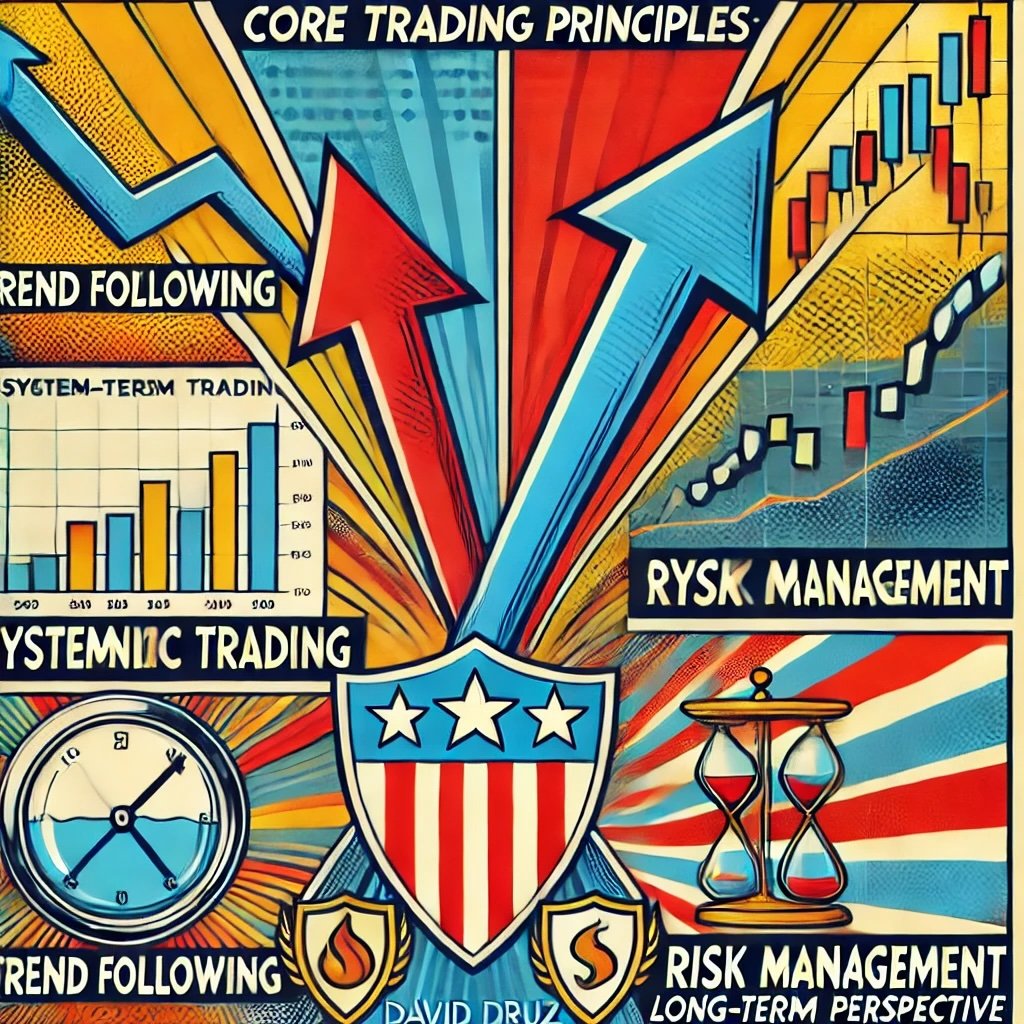
Core Principles of David Druz’s Trading Strategy
David Druz’s trading strategy is built upon a foundation of core principles that guide his decision-making process. These principles focus on trend following, systematic trading, risk management, and maintaining a long-term perspective.
Trend Following: Identifying and Riding Long-Term Market Trends
Understanding Market Trends: Trend following involves identifying the direction in which the market is moving—be it upward, downward, or sideways—and making trading decisions that capitalize on these movements. Druz emphasizes the importance of recognizing sustained trends, as they offer the most reliable opportunities for profit.
Key Components of Trend Following:
- Trend Identification: Utilizing technical indicators such as moving averages, trendlines, and momentum oscillators to identify the direction and strength of market trends.
- Entry and Exit Points: Establishing clear criteria for entering and exiting trades based on trend confirmation signals. This ensures that trades are aligned with the prevailing market direction.
- Trend Confirmation: Waiting for multiple signals to confirm the existence of a trend before committing to a trade, thereby reducing the likelihood of false signals.
Example: When Druz identifies a bullish trend in a particular asset, he enters a long position, aiming to ride the trend until indicators suggest a reversal or the trend loses momentum. Conversely, in a bearish trend, he may enter a short position to capitalize on declining prices.
Tip: Combine multiple technical indicators to confirm trends, enhancing the reliability of your trend identification process and reducing the chances of acting on false signals.
Systematic Trading: Removing Emotions and Sticking to a Rule-Based Approach
The Importance of a Systematic Approach: Systematic trading involves following a predefined set of rules and strategies, minimizing emotional interference in trading decisions. Druz believes that a systematic approach is essential for maintaining consistency and discipline, particularly in volatile markets.
Key Elements of Systematic Trading:
- Predefined Rules: Establishing clear criteria for trade entries, exits, and risk management based on quantitative analysis.
- Automation: Utilizing trading software and algorithms to execute trades automatically based on predefined rules, reducing the impact of human emotions.
- Consistency: Adhering strictly to the trading system, even during periods of drawdowns or market uncertainty, to ensure long-term success.
Example: Druz employs automated trading systems that execute trades based on specific trend-following criteria. This automation ensures that trades are executed consistently, without the influence of fear or greed that can affect manual trading.
Tip: Develop a comprehensive trading plan with clear rules and guidelines, and consider using automation tools to execute trades consistently and objectively.
Risk Management: Capital Preservation Through Position Sizing, Drawdown Control, and Diversification
The Pillars of Risk Management: Effective risk management is crucial for preserving capital and sustaining long-term trading success. Druz employs several risk management techniques to minimize potential losses and protect his trading portfolio.
Key Risk Management Techniques:
- Position Sizing: Determining the appropriate size of each trade based on the overall portfolio size and risk tolerance. This prevents any single trade from having an outsized impact on the portfolio.
- Drawdown Control: Implementing strategies to limit the maximum drawdown—the peak-to-trough decline in portfolio value. This ensures that the portfolio remains resilient during adverse market conditions.
- Diversification: Spreading investments across different asset classes, sectors, and markets to reduce exposure to any single investment. Diversification enhances portfolio stability and reduces risk.
Example: Druz calculates the optimal position size for each trade based on the volatility of the asset and his overall portfolio risk parameters. By diversifying his trades across multiple assets, he minimizes the impact of any single trade’s performance on the overall portfolio.
Tip: Always define your risk parameters before entering a trade. Knowing your maximum acceptable loss helps maintain discipline and prevents emotional decision-making during market turbulence.
Long-Term Perspective: Maintaining Positions Over Extended Periods to Capture Major Market Moves
The Value of Patience: A long-term perspective allows traders to capture significant market movements that may take time to materialize. Druz emphasizes the importance of patience and conviction in holding positions until trends fully develop.
Key Aspects of a Long-Term Perspective:
- Trend Duration: Focusing on trends that show sustained momentum over weeks or months, rather than short-term price fluctuations.
- Avoiding Overtrading: Limiting the number of trades to focus on high-probability setups, thereby reducing transaction costs and the risk of making impulsive decisions.
- Reinforcing Discipline: Maintaining discipline by sticking to the trading system and avoiding the temptation to exit positions prematurely based on short-term market noise.
Example: When Druz identifies a strong upward trend in a stock, he holds the position for an extended period, allowing the trend to fully develop and maximizing potential returns. This long-term approach contrasts with short-term trading strategies that may focus on quick profits but carry higher risks.
Tip: Develop the patience to hold positions over the long term, allowing trends to fully unfold and maximizing the potential for substantial returns.
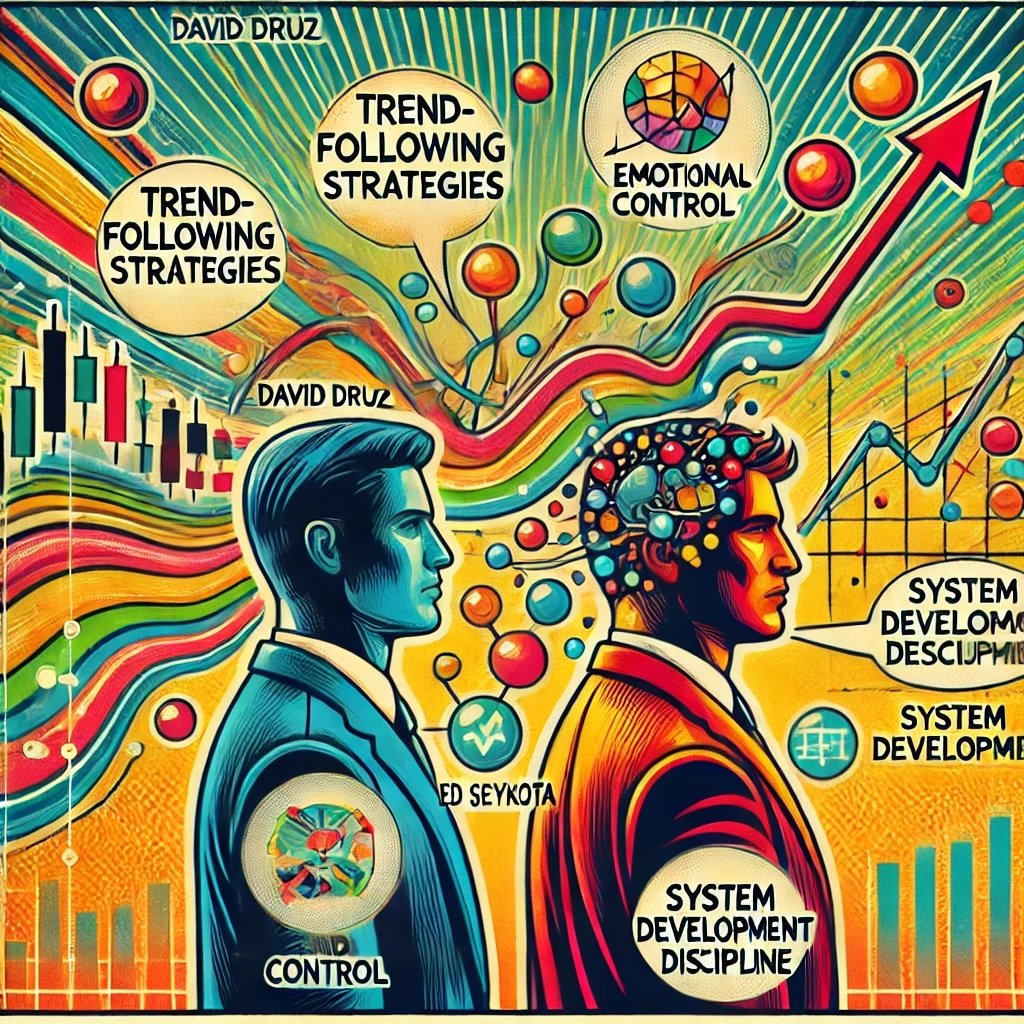
Influences and Mentorship
Overview of Druz’s Mentorship Under Ed Seykota and How It Shaped His Trading Philosophy
One of the most influential figures in David Druz’s trading journey is Ed Seykota, a legendary trader known for his pioneering work in trend-following systems. Seykota’s mentorship provided Druz with invaluable insights into the psychological and technical aspects of trading, emphasizing the importance of discipline, system development, and emotional control.
Key Lessons from Seykota:
- Discipline: Seykota instilled in Druz the importance of sticking to a trading system, regardless of emotional impulses or market noise. This discipline is fundamental to Druz’s systematic approach.
- System Development: Under Seykota’s guidance, Druz learned how to develop robust trading systems that can adapt to different market conditions, ensuring consistency and reliability in trading performance.
- Emotional Control: Seykota emphasized the need to manage emotions and maintain composure, especially during drawdowns or periods of market volatility
Example: During his mentorship, Druz worked closely with Seykota to refine his trading systems, ensuring they were both resilient and adaptable. This collaboration helped Druz develop systems that could consistently identify and capitalize on trends, regardless of market conditions.
Tip: Seek mentorship from experienced traders to gain insights and refine your trading philosophy. Learning from the successes and failures of others can accelerate your own trading development.
How Druz Integrated Seykota’s Principles into His Own Unique Approach
While influenced by Seykota, Druz has developed his own unique approach to trend-following trading. He combines the foundational principles he learned under Seykota with his own innovations and adaptations, creating a trading system that is both robust and flexible.
Key Integrations:
- Enhanced Quantitative Models: Druz has incorporated advanced statistical techniques into his trend-following models, improving the accuracy and reliability of his trading signals.
- Dynamic Position Sizing: Building on Seykota’s emphasis on risk management, Druz employs dynamic position sizing strategies that adjust based on market volatility and trend strength.
- Technological Advancements: Leveraging modern trading technologies, Druz has automated many aspects of his trading systems, increasing execution speed and reducing the potential for human error.
Example: Druz’s trading system uses a combination of moving averages, momentum indicators, and volatility measures to identify and confirm trends. By integrating these elements, he ensures that his system can adapt to varying market conditions, enhancing its overall effectiveness.
Tip: Adapt and evolve your trading strategies by integrating new tools and techniques. Continuously improving your systems ensures they remain effective in changing market environments.
The Importance of Mentorship in Refining Trading Skills and Strategies
Mentorship plays a crucial role in the development of successful traders. For Druz, mentorship under Seykota provided the foundation upon which he built his trading expertise. The guidance, feedback, and support from an experienced mentor can significantly accelerate a trader’s learning curve and help avoid common pitfalls.
Benefits of Mentorship:
- Accelerated Learning: Gaining insights from an experienced mentor can shorten the time it takes to develop effective trading strategies.
- Objective Feedback: Mentors provide unbiased feedback on trading performance, helping traders identify strengths and areas for improvement.
- Emotional Support: Navigating the psychological challenges of trading is easier with the support and encouragement of a mentor.
Example: Druz credits much of his trading success to the mentorship he received from Seykota. The lessons learned during this period have been instrumental in shaping his disciplined and systematic trading approach.
Tip: Actively seek mentorship opportunities to enhance your trading skills and strategies. The experience and knowledge of a seasoned trader can provide invaluable guidance on your trading journey.

Famous Trades and Market Calls
Analysis of Some of Druz’s Most Notable Trades and Market Predictions
David Druz has executed numerous notable trades that highlight the effectiveness of his trend-following strategies. These trades demonstrate his ability to identify and capitalize on significant market trends, often leading to substantial returns with minimal drawdowns.
Notable Trades:
- Tech Stock Boom: During the early 2000s, Druz identified a strong upward trend in technology stocks. By systematically increasing his positions as the trend intensified, he capitalized on the booming tech market, resulting in significant profits as the trend continued.
- Commodity Rally: Druz recognized the beginning of a rally in the commodities market by analyzing trend indicators and market sentiment. His timely entry and disciplined holding allowed him to ride the trend to its peak, yielding impressive returns.
- Financial Crisis Strategy: Amid the 2008 financial crisis, Druz employed his trend-following systems to navigate the volatile markets. By maintaining disciplined trading and adhering to his risk management protocols, he successfully minimized losses and captured profitable trends during the downturn.
How His Strategic Approach and Deep Understanding of Options Led to Significant Successes
Druz’s success in these trades can be attributed to his strategic approach and profound understanding of market dynamics. His ability to blend technical analysis with quantitative models allows him to identify profitable trends and execute trades with precision.
Key Success Factors:
- Early Trend Identification: Druz’s systems are designed to detect emerging trends early, giving him a head start in capitalizing on market movements.
- Disciplined Execution: By adhering strictly to his trading systems, Druz ensures that his trades are based on objective criteria, reducing the influence of emotions.
- Robust Risk Management: His comprehensive risk management techniques protect his portfolio from significant losses, allowing him to sustain long-term trading performance.
Example: In the tech stock boom, Druz’s ability to identify the trend early and increase his positions incrementally as the trend confirmed itself allowed him to maximize his profits while managing risk effectively.
Tip: Combine trend identification with disciplined execution and robust risk management to enhance your trading performance and achieve consistent success.
Lessons Learned from These Trades and Their Relevance in Today’s Markets
1. Importance of Early Trend Identification: Recognizing trends early allows traders to maximize their returns by entering positions before the majority of the market catches on.
2. Discipline in Execution: Sticking to a systematic trading approach ensures that decisions are based on objective criteria rather than emotional impulses, leading to more consistent results.
3. Effective Risk Management: Protecting capital through rigorous risk management techniques is essential for sustaining long-term trading success, especially during volatile market conditions.
4. Adaptability to Market Conditions: Being able to adjust trading strategies based on changing market dynamics enhances the effectiveness of trend-following systems.
Tip: Apply the lessons from successful trades by focusing on early trend identification, maintaining disciplined execution, and implementing effective risk management strategies.
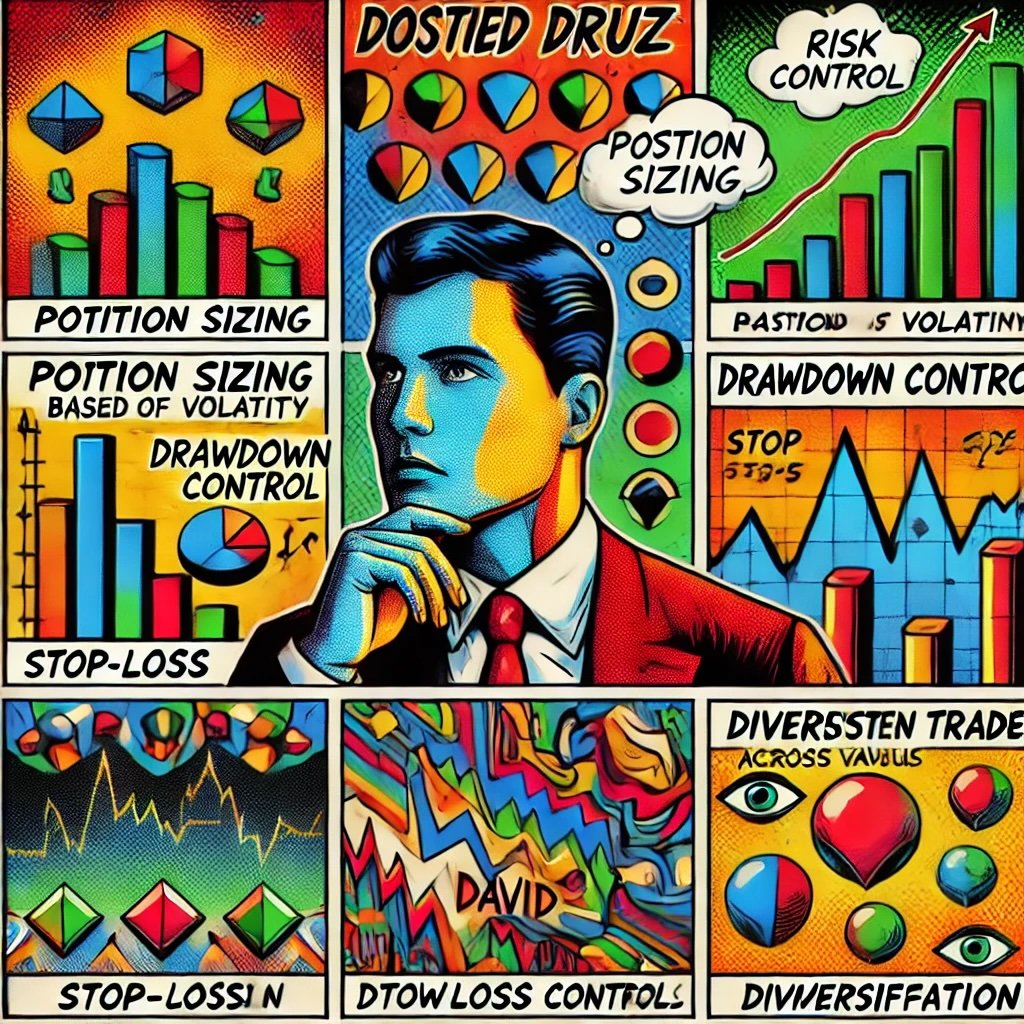
Risk Management Techniques
Detailed Look at Druz’s Approach to Managing Risk in Trend-Following Trading
Risk management is a cornerstone of David Druz’s trading strategy. By implementing comprehensive risk management techniques, Druz ensures that his capital is protected and his portfolio remains resilient against market volatility.
Key Components of Druz’s Risk Management:
- Position Sizing: Determines the appropriate size of each trade based on the overall portfolio size and risk tolerance, preventing any single trade from having an outsized impact.
- Drawdown Control: Implements strategies to limit the maximum drawdown—the peak-to-trough decline in portfolio value. This ensures that the portfolio remains resilient during adverse market conditions.
- Diversification: Spreads investments across different asset classes, sectors, and markets to reduce exposure to any single investment. Diversification enhances portfolio stability and reduces risk.
Use of Volatility-Based Position Sizing, Stop-Loss Strategies, and Diversification Across Markets
Volatility-Based Position Sizing: Druz adjusts his position sizes based on the volatility of the asset being traded. Higher volatility assets receive smaller position sizes to mitigate risk, while lower volatility assets can have larger positions. This dynamic approach ensures that risk is proportionate to market conditions.
Stop-Loss Strategies: Implementing strict stop-loss orders is essential for limiting potential losses. Druz sets predefined price levels at which trades are automatically exited if the market moves against his position. This disciplined approach prevents significant losses and preserves capital for future trading opportunities.
Diversification Across Markets: By diversifying his trades across multiple markets and asset classes, Druz reduces the impact of adverse movements in any single market. This diversification spreads risk and enhances the overall stability of his trading portfolio.
Example: In a volatile market, Druz might reduce his position sizes and tighten stop-loss levels to limit potential losses. Simultaneously, he diversifies his trades across different sectors, ensuring that a downturn in one market segment does not significantly impact his overall portfolio.
Tip: Utilize volatility-based position sizing, implement strict stop-loss orders, and diversify your trades across multiple markets to effectively manage risk and enhance portfolio stability.
Balancing Risk and Reward in a Highly Systematic Trading Environment
Balancing risk and reward is vital for sustaining long-term trading success, especially in a systematic trading environment. Druz employs several strategies to achieve this balance:
- Optimal Asset Allocation: Distributes investments across various assets to spread risk and enhance potential returns.
- Risk-Reward Analysis: Assesses the potential returns of each trade relative to its risk, aiming for trades with favorable risk-reward ratios.
- Diversified Portfolio: Maintains a diversified portfolio to reduce the impact of any single trade’s performance on the overall portfolio.
Example: In a highly systematic trading environment, Druz might allocate a portion of his portfolio to trend-following strategies, another portion to hedging strategies, and yet another to opportunistic trades based on market conditions. This balanced approach ensures that risk is spread across different strategies, enhancing the overall risk-return profile of the portfolio.
Tip: Regularly review and adjust your asset allocation and risk-reward ratios to maintain an optimal balance between risk and reward, adapting to changing market conditions.

The Role of Psychology in Trading
Druz’s Views on the Psychological Challenges of Systematic Trading
David Druz recognizes that trading is as much a psychological endeavor as it is a technical one. The emotional highs and lows, the pressure of making quick decisions, and the fear of losses can significantly impact trading performance. Druz emphasizes the importance of mastering the psychological aspects of trading to achieve consistent success.
Key Psychological Challenges:
- Emotional Trading: Making decisions based on emotions like fear, greed, or excitement rather than rational analysis.
- Overconfidence: Believing too much in one’s own trading abilities, leading to excessive risk-taking.
- Loss Aversion: The tendency to prefer avoiding losses over acquiring gains, which can result in holding onto losing positions too long.
- Stress and Pressure: Managing the stress that comes with the high-stakes environment of trading.
Techniques for Maintaining Discipline and Emotional Control in Long-Term Trend-Following
To navigate the psychological challenges of trading, Druz employs several techniques aimed at fostering discipline and emotional resilience:
- Structured Trading Plan: Having a detailed trading plan that outlines entry and exit criteria, risk management rules, and performance benchmarks helps maintain focus and prevent impulsive decisions.
- Mindfulness and Stress Management: Practices like meditation, deep breathing exercises, and regular physical activity help Druz manage stress and maintain mental clarity, enabling him to stay calm and focused during trading sessions.
- Regular Performance Reviews: Conducting periodic reviews of his trading performance allows Druz to identify patterns of emotional decision-making and adjust his strategies accordingly.
- Goal Setting: Setting clear, achievable trading goals provides direction and motivation, helping Druz stay committed to his strategies even during challenging market conditions.
Example: During a period of high market volatility, Druz remains calm and adheres to his trading plan instead of succumbing to panic selling or impulsive buying. This disciplined approach helps him navigate turbulent markets without incurring unnecessary losses.
Tip: Develop a structured routine that includes stress management techniques and regular performance reviews to maintain emotional control and discipline in your trading.
The Importance of Mental Resilience and Patience in Executing Trading Systems
Mental resilience is crucial for overcoming the inevitable setbacks and challenges in trading. Druz emphasizes the need to build mental toughness to handle losses, stay motivated, and maintain a positive outlook.
Strategies to Build Mental Resilience:
- Acceptance of Losses: Recognizing that losses are a natural part of trading and learning from them rather than dwelling on them.
- Positive Mindset: Maintaining a positive attitude and focusing on long-term goals instead of short-term setbacks.
- Continuous Learning: Viewing each trading experience as an opportunity to learn and improve, thereby fostering a growth mindset.
- Support Systems: Engaging with mentors, peers, and support networks to gain perspective and encouragement during tough times.
Example: After experiencing a series of losing trades, Druz reviews his strategies to identify areas for improvement. Instead of getting discouraged, he uses the experience as a learning opportunity to refine his approach and enhance his future trading performance.
Tip: Cultivate a growth mindset by viewing challenges as opportunities for learning and improvement. This approach helps you stay resilient and adaptable in the face of trading setbacks.
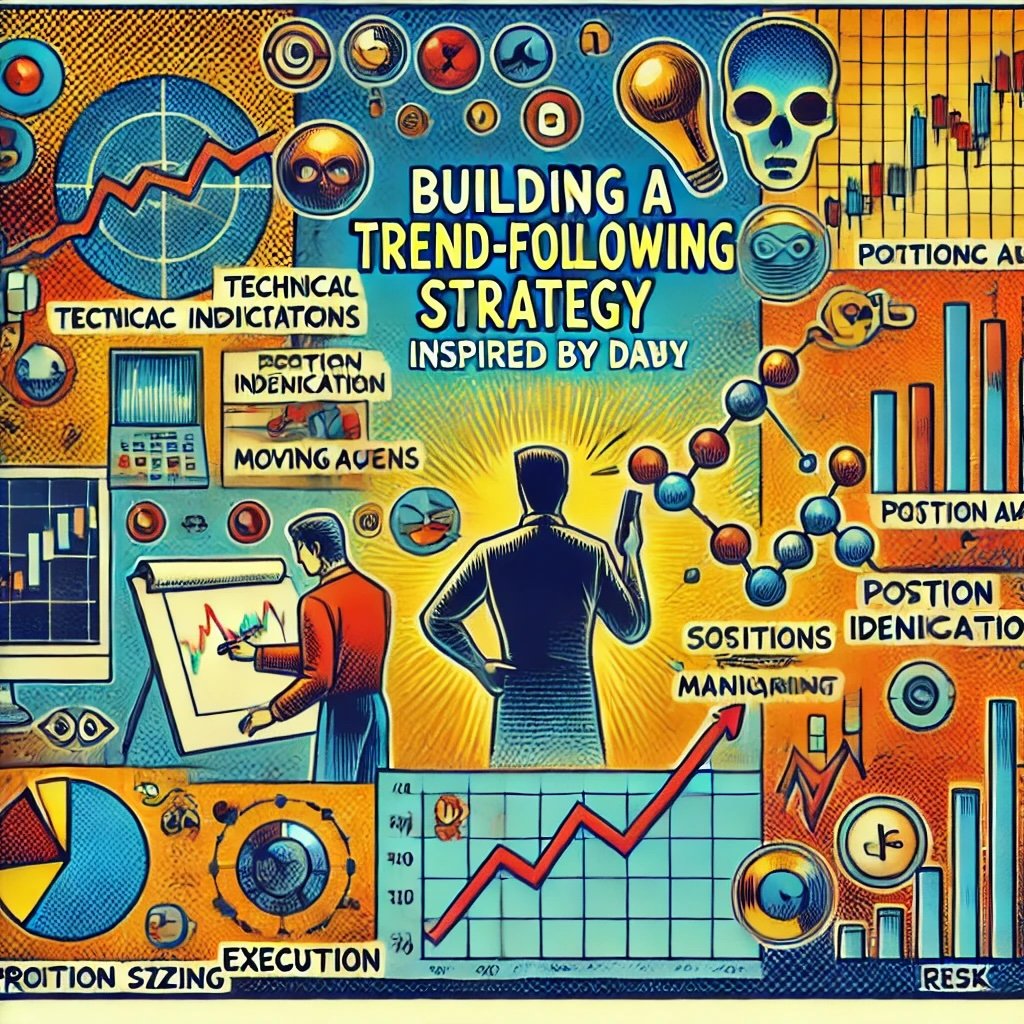
Building a Trend-Following Strategy Like David Druz
Step-by-Step Guide to Developing a Trend-Following Strategy Inspired by Druz
Emulating David Druz’s trading strategies involves adopting his disciplined approach to trend following, systematic trading, and risk management. Here’s a practical guide to developing a trend-following trading strategy inspired by Druz.
1. Research and Analysis
- Comprehensive Market Research: Begin by conducting thorough research on the markets you intend to trade. Understand the factors that influence price movements, such as supply and demand dynamics, economic indicators, and geopolitical events.
- Technical and Fundamental Analysis: Combine technical analysis (chart patterns, moving averages, RSI) with fundamental analysis (earnings reports, economic indicators) to identify high-potential trading opportunities.
- Use of Quantitative Models: Incorporate statistical models and algorithms to analyze market data, identifying patterns and trends that can inform your trading decisions.
2. Identifying and Analyzing Potential Trades
- Trend Identification: Use technical indicators like moving averages, trendlines, and momentum oscillators to identify prevailing market trends. Look for consistent higher highs and higher lows in bullish trends or lower highs and lower lows in bearish trends.
- Trend Confirmation: Wait for multiple signals to confirm the existence of a trend before committing to a trade. This reduces the likelihood of acting on false signals and enhances the reliability of your trades.
- Entry and Exit Points: Establish clear criteria for entering and exiting trades based on trend confirmation signals. For example, entering a long position when the price breaks above a moving average and exiting when it falls below another moving average.
3. Implementing Risk Management Strategies
- Position Sizing: Determine the appropriate size of each trade based on the overall portfolio size and risk tolerance. Use a fixed percentage of your portfolio for each trade to ensure that no single trade can significantly impact your capital.
- Stop-Loss Orders: Set stop-loss orders to limit potential losses. Define the maximum loss you are willing to accept for each trade and place a stop-loss order accordingly.
- Diversification: Spread your investments across different markets and asset classes to reduce exposure to any single investment. Diversification enhances portfolio stability and reduces risk.
4. Executing the Trading Plan
- Strategic Entry and Exit Points: Identify optimal entry points using trend-following indicators and set predefined exit points to lock in profits or limit losses.
- Automated Trading Systems: Utilize automated trading systems to execute trades based on your trend-following criteria. Automation ensures consistency and eliminates the influence of emotions in trading decisions.
- Continuous Monitoring: Regularly monitor your trades and the broader market conditions to ensure that your positions remain aligned with your trading objectives. Adjust your strategies as needed based on market developments.
5. Continuous Evaluation and Adaptation
- Performance Review: Conduct regular reviews of your trading performance to assess the effectiveness of your strategies and identify areas for improvement.
- Adapt to Market Conditions: Be prepared to adjust your strategies based on changing market dynamics, economic indicators, and emerging trends.
- Innovate and Refine: Incorporate new trading techniques and tools to enhance your strategy and stay ahead of market developments.
Tips for Refining and Adapting the Strategy Over Time
- Stay Flexible: Be willing to pivot your strategy as new information and trends emerge. Flexibility allows you to capitalize on unexpected opportunities and mitigate emerging risks.
- Learn Continuously: Invest in your education to stay ahead of market developments. Attend seminars, read extensively, and engage with financial experts to enhance your knowledge.
- Seek Expertise: Collaborate with analysts and industry experts to gain diverse perspectives. Leveraging specialized knowledge can provide deeper insights into complex markets.
- Implement Feedback Loops: Use feedback from performance reviews and market analyses to iteratively improve your strategy, ensuring it remains robust and effective.
Tip: Regularly review and adjust your trading strategy to incorporate new insights and respond to evolving market conditions, ensuring sustained performance and growth.
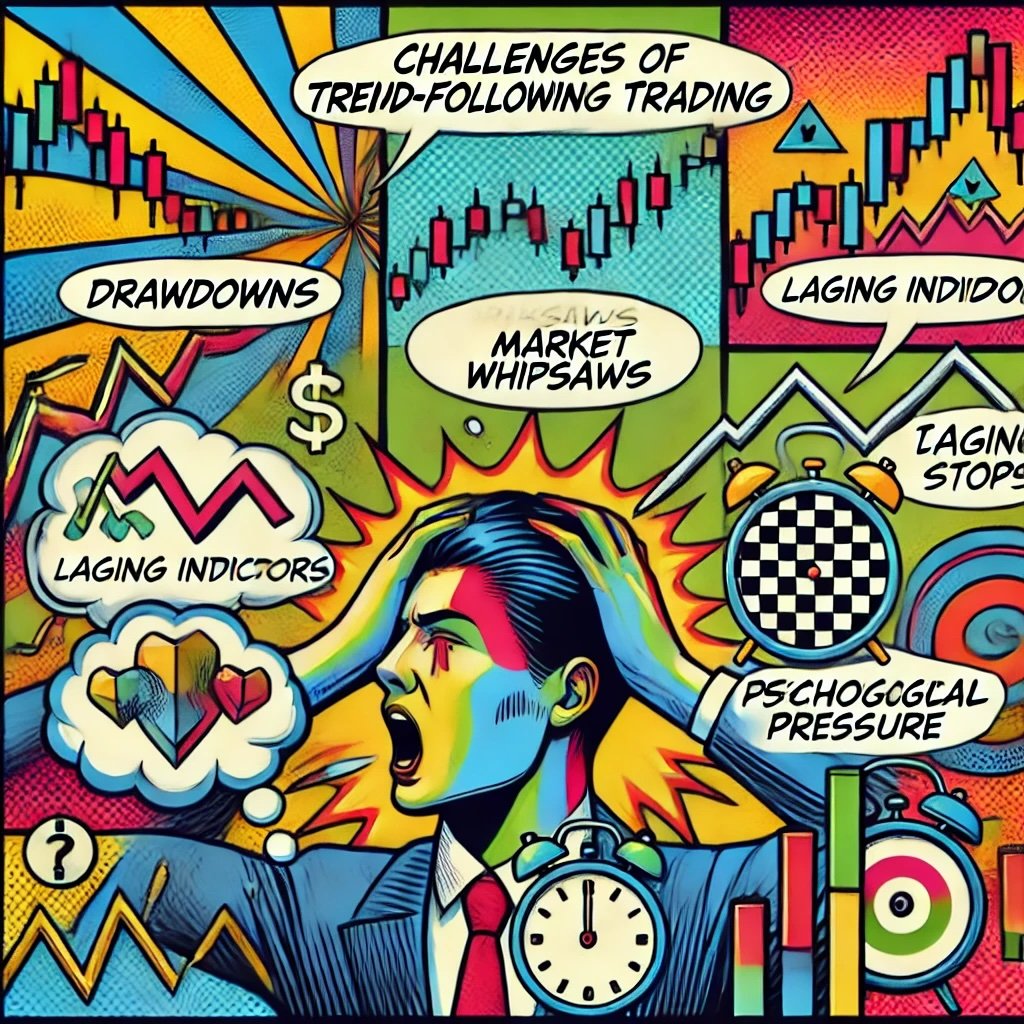
Challenges of Trend-Following Trading
Potential Pitfalls and Difficulties in Adopting a Trend-Following Approach
While trend-following strategies can be highly effective, they are not without their challenges. Understanding these potential pitfalls is essential for developing a resilient and effective trading strategy.
Common Challenges:
- Drawdowns: Trend-following systems can experience significant drawdowns during periods of market consolidation or reversals. Managing these drawdowns is crucial for preserving capital and maintaining trading discipline.
- Market Whipsaws: Rapid price fluctuations can trigger stop-loss orders prematurely, leading to missed opportunities or unnecessary losses.
- Lagging Indicators: Many trend-following indicators are based on historical data and can lag behind real-time market movements, causing delayed trade entries or exits.
- Overfitting: Designing trading systems that perform exceptionally well on historical data but fail to generalize to live markets. Overfitting can lead to poor real-world performance.
- Psychological Pressure: Maintaining discipline and sticking to the trading system during periods of losses or prolonged drawdowns can be psychologically challenging.
How to Overcome Common Challenges Such as Drawdowns and Market Whipsaws
Managing Drawdowns:
- Implement Robust Risk Management: Use position sizing and stop-loss orders to limit the impact of drawdowns on your portfolio.
- Diversify Your Portfolio: Spread your investments across different markets and asset classes to reduce the likelihood of significant drawdowns in any single area.
- Stay Disciplined: Adhere strictly to your trading plan and avoid making impulsive decisions based on emotions or short-term market noise.
Mitigating Market Whipsaws:
- Use Trailing Stops: Implement trailing stop-loss orders that adjust based on market movements, allowing you to lock in profits while providing room for the trend to develop.
- Confirm Trends with Multiple Indicators: Rely on a combination of trend-following indicators to confirm the strength and direction of a trend, reducing the chances of acting on false signals.
- Avoid Overtrading: Limit the number of trades to focus on high-probability setups, thereby reducing the impact of market whipsaws on your portfolio.
Example: During a period of high volatility, Druz might tighten his trailing stops and rely on multiple trend confirmation signals to avoid getting caught in false breakouts or reversals.
Tip: Combine multiple trend-following indicators and employ advanced risk management techniques to navigate the challenges of drawdowns and market whipsaws effectively.
The Importance of Adaptability and Continuous Improvement in Trading Systems
Markets are dynamic, and trading systems must evolve to remain effective. Adaptability and continuous improvement are essential for sustaining long-term trading success.
Key Strategies for Adaptability:
- Regular System Reviews: Periodically review and assess the performance of your trading systems to identify areas for improvement.
- Incorporate New Data: Integrate new market data and indicators into your trading models to enhance their predictive accuracy.
- Stay Informed: Keep abreast of market developments, economic indicators, and technological advancements that can impact your trading strategies.
Continuous Improvement Practices:
- Backtesting and Optimization: Continuously backtest and optimize your trading systems to ensure they remain effective under varying market conditions.
- Embrace Innovation: Explore new trading techniques, technologies, and methodologies to enhance your trading systems and maintain a competitive edge.
- Learn from Experience: Analyze past trades, both successful and unsuccessful, to extract valuable lessons and refine your trading approach.
Example: As market conditions shift, Druz might adjust his trend-following parameters or incorporate new indicators to adapt to the changing dynamics, ensuring his systems remain robust and effective.
Tip: Foster a mindset of continuous learning and adaptability, allowing your trading systems to evolve alongside the markets and maintain their effectiveness over time.
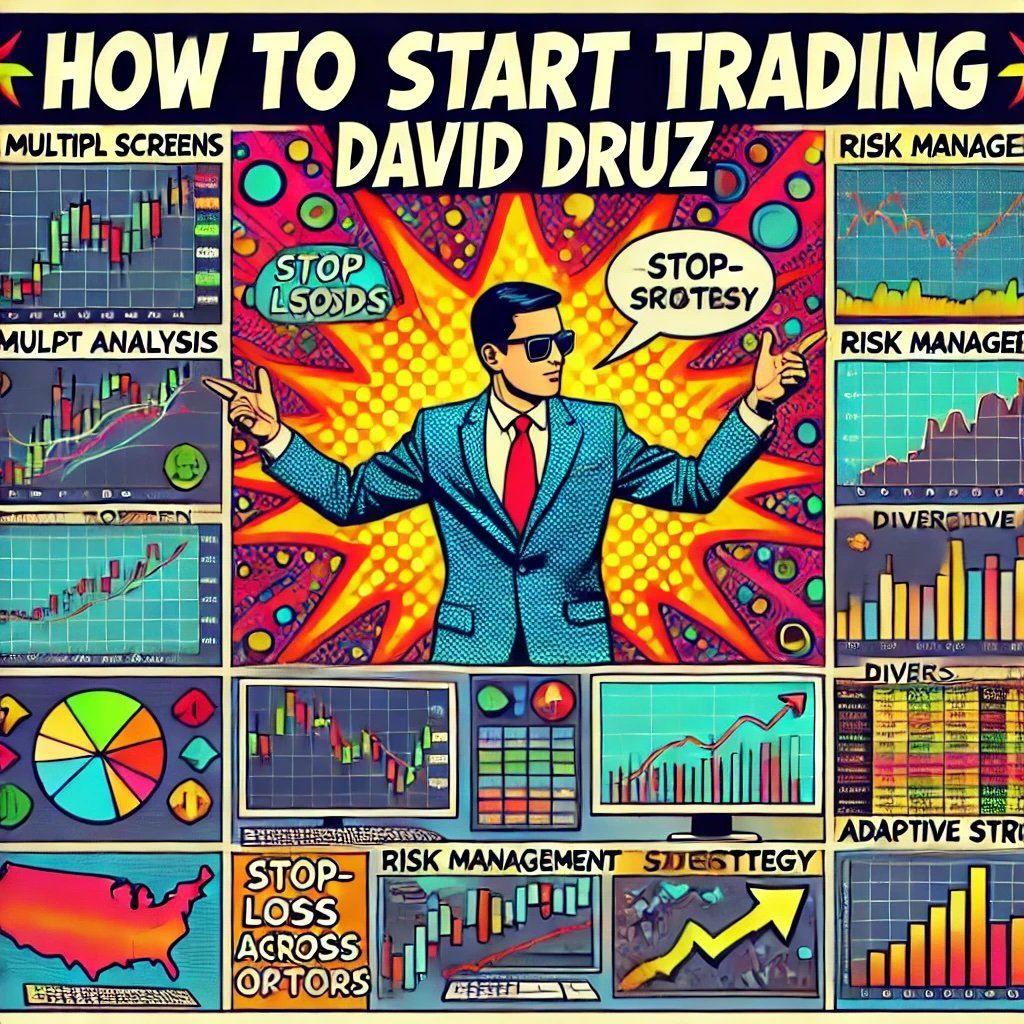
How to Start Trading Like David Druz
Practical Steps for Implementing Druz’s Strategies in Your Own Trading
Emulating David Druz’s trading strategies involves adopting his disciplined approach to trend following, systematic trading, and risk management. Here’s a practical guide to implementing Druz’s strategies in your own trading.
1. Develop a Comprehensive Research Process
- In-Depth Market Analysis: Conduct thorough research on the markets you intend to trade. Understand the factors that influence price movements, such as supply and demand dynamics, economic indicators, and geopolitical events.
- Technical and Fundamental Analysis: Combine technical analysis (chart patterns, moving averages, RSI) with fundamental analysis (earnings reports, economic indicators) to identify high-potential trading opportunities.
- Use of Quantitative Models: Incorporate statistical models and algorithms to analyze market data, identifying patterns and trends that can inform your trading decisions.
2. Implement Robust Risk Management Practices
- Capital Preservation: Prioritize the protection of your invested capital by avoiding overly risky trades and focusing on high-probability setups.
- Position Sizing: Determine the appropriate size of each position based on the risk profile of the asset and your overall portfolio strategy.
- Use of Stop-Loss Orders: Implement stop-loss orders to limit potential losses and protect your capital from significant downturns.
3. Adopt a Diversified Portfolio Approach
- Asset Class Diversification: Invest across various markets and asset classes to spread risk and enhance portfolio stability.
- Sector and Geographic Diversification: Spread your investments across different sectors and regions to mitigate the impact of sector-specific downturns or regional economic challenges.
- Balanced Exposure: Ensure a balanced exposure to high-growth and defensive sectors to maintain portfolio stability.
4. Integrate Behavioral Finance Principles
- Recognize Biases: Identify and mitigate common cognitive biases that can impair investment decision-making.
- Maintain Emotional Discipline: Stick to your investment plan and avoid making impulsive decisions based on emotions.
- Focus on Long-Term Goals: Prioritize long-term growth over short-term gains to ensure sustained investment performance.
5. Maintain an Adaptive Trading Strategy
- Monitor Market Conditions: Continuously assess market conditions and adjust your trading strategy accordingly.
- Stay Flexible: Be prepared to pivot your strategy in response to new information, emerging trends, and changing market dynamics.
- Innovate and Refine: Incorporate new trading techniques and tools to enhance your strategy and stay ahead of market developments.
Resources for Learning More About Trend-Following and Systematic Trading Techniques
- Books:
- “Trend Following” by Michael Covel
- “Enhancing Trader Performance” by Brett N. Steenbarger
- “Systematic Trading” by Robert Carver
- Online Courses:
- Coursera’s Machine Learning for Trading
- Udemy’s Algorithmic Trading: Backtest, Optimize & Automate in Python
- edX’s Trading Strategies in Emerging Markets
- Professional Certifications:
- Chartered Financial Analyst (CFA)
- Chartered Market Technician (CMT)
- Seminars and Webinars:
- Attend industry conferences and webinars hosted by reputable financial institutions and trading firms.
- Participate in online trading communities and forums to exchange insights and strategies with other traders.
Tools and Platforms to Support Trend-Following Trading Activities
- Analytical Tools:
- TradingView: Advanced charting platform with a wide range of technical indicators and social networking features for traders.
- MetaTrader 4/5: Popular trading platforms offering extensive technical analysis tools and automated trading capabilities.
- Bloomberg Terminal: Comprehensive platform for financial data, news, and analytics.
- Trading Platforms:
- Interactive Brokers: Offers low-cost commissions, advanced trading tools, and a wide range of investment options.
- Thinkorswim by TD Ameritrade: Robust platform with advanced charting and trading capabilities.
- E*TRADE Pro: Professional-grade trading platform with extensive research tools and real-time data.
- Portfolio Management Software:
- Portfolio Visualizer: Tool for portfolio analysis, backtesting, and optimization.
- Personal Capital: Comprehensive financial planning and portfolio management platform.
- Quicken: Personal finance management tool with investment tracking features.
Tip: Invest in high-quality analytical and trading tools to enhance your investment analysis and execution capabilities, enabling you to make informed and strategic trading decisions.
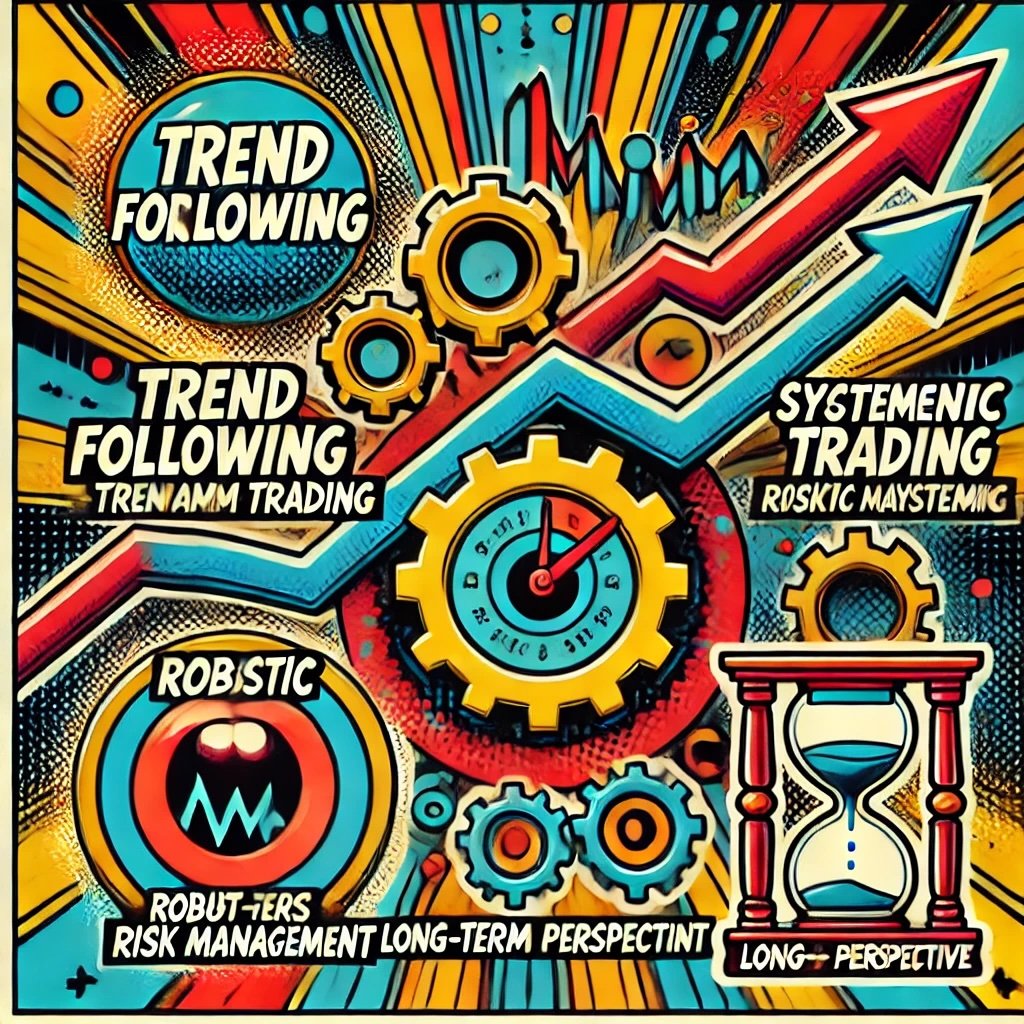
Key Takeaways from David Druz’s Trading Approach
David Druz’s trading approach is a blend of disciplined trend following, systematic trading, robust risk management, and maintaining a long-term perspective. By focusing on identifying and riding long-term market trends, adhering to a rule-based trading system, and implementing comprehensive risk management techniques, Druz has consistently achieved impressive returns with minimal drawdowns. His commitment to discipline and continuous improvement has established him as a leading figure in the trend-following trading community.
Key Takeaways:
- Trend Following: Emphasizing the identification and capitalization of long-term market trends to maximize returns.
- Systematic Trading: Adhering to a rule-based approach that removes emotional biases from trading decisions, ensuring consistency and reliability.
- Risk Management: Prioritizing capital preservation through position sizing, drawdown control, and diversification to protect the portfolio from significant losses.
- Long-Term Perspective: Maintaining positions over extended periods to capture major market moves, demonstrating patience and conviction.
- Mentorship and Education: Leveraging mentorship from experienced traders like Ed Seykota and contributing to the trading community through education and mentorship.
Final Thoughts on the Relevance of Trend-Following in Today’s Markets
In today’s fast-paced and technologically advanced financial markets, the principles of trend-following trading remain highly relevant. The ability to identify and capitalize on sustained market movements offers a reliable path to consistent returns, even amidst market volatility. Druz’s systematic and disciplined approach to trend-following ensures that his trading strategies remain robust and adaptable to changing market conditions.
Relevance in Modern Markets:
- Technological Integration: Leveraging advanced trading technologies and quantitative models enhances the ability to identify trends accurately and execute trades efficiently.
- Globalization: Understanding global market trends and their interconnections allows for better diversification and risk management.
- Market Volatility: Robust trend-following strategies can effectively navigate volatile markets, capturing profitable trends while minimizing losses.
- Behavioral Insights: Incorporating behavioral finance principles helps mitigate emotional biases, enhancing trading discipline and performance.
Example: In an era where algorithmic and high-frequency trading dominate, Druz’s blend of quantitative analysis and systematic trend-following provides a balanced approach that can withstand rapid market changes and capitalize on emerging opportunities.
Explore and Experiment with These Strategies
Emulating David Druz’s trading strategies requires dedication, discipline, and a commitment to continuous learning. However, the rewards of adopting his methodologies can be substantial, offering a path to consistent and sustainable trading success. Here are some actionable steps to get you started:
- Adopt a Trend-Following Mindset: Embrace the principles of trend following by focusing on identifying and riding long-term market trends. Use technical indicators and quantitative models to enhance your trend identification process.
- Implement a Systematic Trading Plan: Develop a comprehensive trading plan that outlines your entry and exit criteria, risk management rules, and performance benchmarks. Stick to this plan to maintain discipline and consistency in your trading.
- Prioritize Risk Management: Use position sizing, stop-loss orders, and diversification to manage risk effectively. Protect your capital by ensuring that no single trade can significantly impact your portfolio.
- Leverage Technology and Quantitative Models: Invest in advanced trading platforms and analytical tools to enhance your trading capabilities. Utilize quantitative models to analyze market data and inform your trading decisions.
- Seek Mentorship and Education: Learn from experienced traders and seek mentorship opportunities to gain valuable insights and refine your trading strategies. Attend seminars, workshops, and engage with the trading community to expand your knowledge.
- Commit to Continuous Improvement: Regularly review and assess your trading performance, and be prepared to adapt and refine your strategies based on market developments and performance feedback.
- Maintain Mental Resilience: Cultivate a strong mental attitude by practicing stress management techniques and maintaining emotional control. Understand that losses are part of trading and use them as learning opportunities to enhance your strategies.
David Druz Trend-Following Investing — 12-Question FAQ (Rules, Risk, Entries/Exits, Position Sizing, and Psychology)
Who is David Druz and why is he notable?
David Druz is a systematic, rules-based trend follower best known from the Market Wizards lineage, combining quantified entries/exits with strict risk controls and an emphasis on riding major trends while capping downside.
What is the core idea of trend following in the Druz style?
Trade in the direction of persistent price moves: buy strength, sell weakness, and let winners run with trailing stops. Price action—not predictions—drives decisions, with rules defining when to enter, add, reduce, and exit.
How do entries typically work for a Druz-like system?
Use objective breakouts or moving-average rules (e.g., highest X-day close or price > long MA plus volatility filter). Entries are confirmed by breadth/volatility checks to avoid low-quality signals; no discretionary overrides.
How are exits determined?
Exits are mechanized: trailing stops (ATR-based), moving-average cross-unders, or a lowest-X-day stop. Exits trigger regardless of news or opinion—protecting capital and crystallizing the “cut losers, keep winners” edge.
How does position sizing manage risk?
Size by volatility so each trade risks a similar fraction of equity (e.g., 0.25%–1.0% per position using ATR or stdev). Higher-volatility markets get smaller size; lower-volatility markets get larger—equalizing risk contributions.
What drawdown controls are used?
Portfolio-level max loss per day/week, caps on correlated exposure, halting new trades after a hit threshold, and step-down risk (reduce per-trade risk when equity falls). These rules limit compounding losses during chop.
Which markets fit a Druz-style portfolio?
A wide, liquid mix: global equity indices, rates, FX, commodities (energies, metals, ags, softs), and possibly crypto futures. The edge improves with diversity—different trend cycles and shock regimes.
How do you avoid getting chopped in whipsaws?
Require confirmation (e.g., breakout + volatility expansion), use regime filters (above/below medium-term MA), and trade smaller in high-noise phases. Accept that whipsaws are the “cost of admission,” priced into expectancy.
What’s the mindset for handling long trend cycles?
Radical patience. Accept small frequent losses and long flat periods so you’re present for the few large outlier gains. Journal rules, automate execution, and judge the process over multi-quarter/annual horizons—not days.
How are adds and pyramids handled safely?
Add only when unrealized profit exists and volatility remains supportive; each add is smaller than the prior (“decreasing unit pyramid”) and all adds sit behind a unified trailing stop to prevent a late add from ruining the trade.
How do you test and maintain a Druz-like system?
Use walk-forward and out-of-sample tests, Monte Carlo on trade sequences, parameter robustness sweeps, and ongoing capacity/liquidity checks. Track live drift vs. backtest and refresh risk parameters as volatility regimes change.
What are the most common mistakes to avoid?
Oversizing, curve-fitting entries, over-trading correlated markets, discretionary overrides after a few losses, and abandoning the system during normal drawdowns. The fix: smaller risk, simpler rules, and strict adherence.
Important Information
Comprehensive Investment Disclaimer:
All content provided on this website (including but not limited to portfolio ideas, fund analyses, investment strategies, commentary on market conditions, and discussions regarding leverage) is strictly for educational, informational, and illustrative purposes only. The information does not constitute financial, investment, tax, accounting, or legal advice. Opinions, strategies, and ideas presented herein represent personal perspectives, are based on independent research and publicly available information, and do not necessarily reflect the views or official positions of any third-party organizations, institutions, or affiliates.
Investing in financial markets inherently carries substantial risks, including but not limited to market volatility, economic uncertainties, geopolitical developments, and liquidity risks. You must be fully aware that there is always the potential for partial or total loss of your principal investment. Additionally, the use of leverage or leveraged financial products significantly increases risk exposure by amplifying both potential gains and potential losses, and thus is not appropriate or advisable for all investors. Using leverage may result in losing more than your initial invested capital, incurring margin calls, experiencing substantial interest costs, or suffering severe financial distress.
Past performance indicators, including historical data, backtesting results, and hypothetical scenarios, should never be viewed as guarantees or reliable predictions of future performance. Any examples provided are purely hypothetical and intended only for illustration purposes. Performance benchmarks, such as market indexes mentioned on this site, are theoretical and are not directly investable. While diligent efforts are made to provide accurate and current information, “Picture Perfect Portfolios” does not warrant, represent, or guarantee the accuracy, completeness, or timeliness of any information provided. Errors, inaccuracies, or outdated information may exist.
Users of this website are strongly encouraged to independently verify all information, conduct comprehensive research and due diligence, and engage with qualified financial, investment, tax, or legal professionals before making any investment or financial decisions. The responsibility for making informed investment decisions rests entirely with the individual. “Picture Perfect Portfolios” explicitly disclaims all liability for any direct, indirect, incidental, special, consequential, or other losses or damages incurred, financial or otherwise, arising out of reliance upon, or use of, any content or information presented on this website.
By accessing, reading, and utilizing the content on this website, you expressly acknowledge, understand, accept, and agree to abide by these terms and conditions. Please consult the full and detailed disclaimer available elsewhere on this website for further clarification and additional important disclosures. Read the complete disclaimer here.

